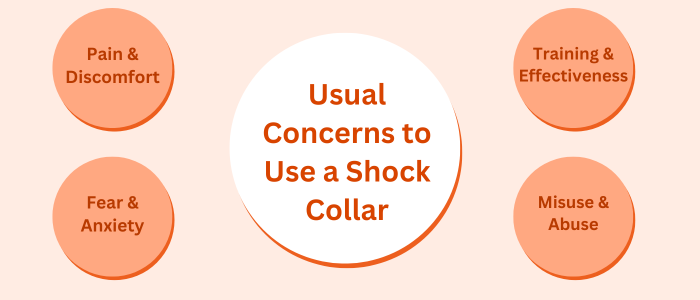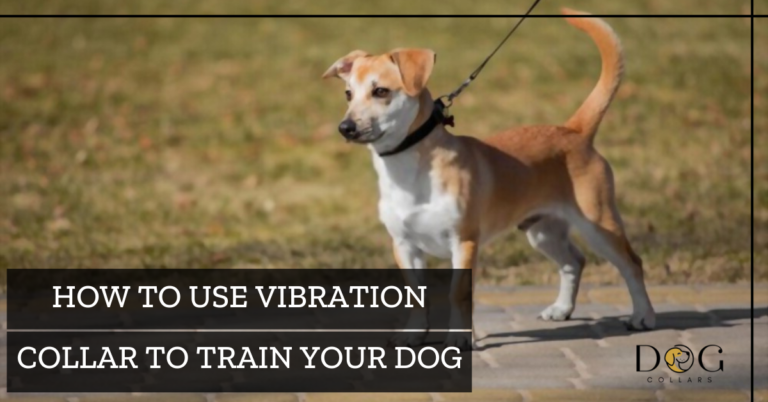When is a Dog Old Enough For A Shock Collar – Explained by Experts

I remember the day when I brought my tiny puppy home. He was so cute that even his barking was barely audible. But as he grew up, his behavior became more challenging to handle. It was a wake-up call that my sweet little pup was no longer a baby and needed training to behave appropriately.
The question on every dog owner’s mind is: when is a dog old enough for a shock collar? Age is not the only factor to consider when deciding if a shock collar is appropriate for your dog. It’s important to carefully evaluate the behavior of your pup, behavior, and individual needs before using a shock collar as a guidance tool.
According to the American Kennel Club, shock collars should only be used as a last resort. Ultimately, the decision to use a shock collar should be made after careful consideration and consultation with a professional trainer.
Let’s explore the world of shock collars together and see if they’re the right fit for your pup.
Factors To Be Considered When Is A Dog Old Enough For A Shock Collar
When it comes to determining the appropriate age for e-collar use, there are several important factors to consider.

- The Temperament Of The Dog
When thinking about using a static collar, we should consider how our fluffy friends react to training. Some dogs are more sensitive than others, so we need to take their attitude into account.
- History Of Abuse Or Trauma
Hey dog lovers! Aggressive dog reactions are due to a history of abuse or trauma. It’s important to be mindful of their history and use effective training techniques to build trust and confidence.
- Health Conditions
Just a quick reminder! When it comes to vibrating collars for our young dogs, their health is a huge factor to keep in mind. If your fluffy friend has any underlying health issues, like heart problems or a history of seizures, using an electronic device could really make things worse.
- Training Goals
If we’re looking to stop a specific reaction, like a nuisance and aggressive behavior there are plenty of other training techniques we can try before resorting to a static collar.
- Owner’s Experience And Training Ability
If we’re feeling a bit unsure about how to guide our pups or we don’t have the necessary skills, it’s totally okay to seek help from a professional dog trainer.
Usual Concerns to Use a Shock Collar
Some of the usual concerns about training collars include,

- Pain And Discomfort
Many people asked me whether it is safe to put an e-collar on puppies. And honestly, I totally get it! Training collars can be painful and uncomfortable for our furry friends, especially if we’re not using them right or at super high-intensity levels. Let’s be careful and always put our pup’s comfort first!
2. Fear And Anxiety:
Here I have a gentle reminder for my fellow pup moms and dads! training collars can cause fear and anxiety in pups if not used properly. Let’s use them with care and prioritise our pup’s well-being.
3. Training Effectiveness:
Now I will tell you while training collars can be effective in some cases, there is also concern that they may not be the best tool for every dog’s guidance. In some cases, positive reinforcement dog training methods may be more effective and less stressful for the woofer.
4. Misuse And Abuse:
Hey there! Electric collars can be dangerous if not used properly. Pressing the button on a bark collar without proper guidance can lead to misuse and harm to your dog. Professional guidance and responsible use are crucial for the safety and well-being of dogs.
5. Legal And Ethical Concerns:
Calling all enthusiasts! The use of static collars raises legal and ethical concerns in some jurisdictions, where their use is restricted or even banned. In such cases, E-collars may be considered a form of animal abuse.
When it comes to my fluffy friend’s well-being, I don’t take any risks. I skipped work to consult with professional trainers and veterinarians about using an electronic collar on my young dog. I gathered their advice and put it all in an article for you to read. Check it out!
At What Age Can I Start E-Collar Training?
When it comes to collar use, it is important to learn at what age can I start e-collar training. Here are some key points to consider:
- Developmental Stages Of Dogs And How They Relate To Static Collar Use:
- Puppies go through different developmental stages that affect their gestures and learning.
- The use of Vibrating or electric collars is not appropriate during the first few weeks of life and during the critical socialization period (3-12 weeks).
- Basic obedience training using positive reinforcement should be introduced during the juvenile period (3-6 months).
- Anti-bark collar use may be introduced during the juvenile period if the dog has already responded to effective training methods.
- More advanced training techniques, including anti-bark collar use, may be necessary during the adolescent stage (6-12 months).
- Physical And Cognitive Maturity Of Dogs And How It Affects E-Collar Use:
Both the physical and cognitive maturity of dogs should be considered before using vibrating devices. Small breeds may mature physically faster but may not be fully cognitively mature until over a year old. Large breeds may take longer to mature physically but maybe cognitively mature by one year old.
- Appropriate Age To Use An Electronic Collar Based On Breed And Size:
Age and breed/size influence remote collar use. Small breeds need a later introduction and lower intensity, while medium-large breeds can start earlier with professional guidance. E-collars should not be used on dogs under six months of age.
Pros And Cons Of Training Tools
Remote collars are a controversial tool used in pooch training. Here are some of the Pros and cons,
- Benefits Of Using An Electric Or Vibration Collar In Dog Training:
- Can be an effective tool for training specific gestures, such as recall and boundary training.
- Can be used to deter undesired reactions, such as excessive yelping or aggression.
- Allows for remote training and can be helpful for training dogs off-leash.
- Risks And Potential Harms Of Remote Training Equipment:
- Can cause physical pain and discomfort, and may cause psychological distress in some dogs.
- Can create fear and anxiety in dogs, which can lead to further attitude problems.
- Can cause physical harm if used incorrectly or at high intensity.
- Ethical Considerations Of The Shock Collar Use:
- Some people argue that electronic training instruments are inhumane and cruel, and that beneficial reinforcement should be the primary method of training.
- Research On The Effectiveness Of Shock Collars:
- Some studies have found that training gadgets can be effective in reducing unwanted attitudes, but only when used appropriately and in combination with effective reinforcement training.
- Other studies have found that valuable reinforcement training is more effective than using e-collars and they can have negative impacts on dog welfare and health.
Alternatives To Training Collars
Shock collars are a controversial tool in pet guidance, and some people believe that there are more humane and effective alternatives. Here are some alternatives to e-collars:
- Alternatives to shock chains include optimistic reinforcement training, clicker training, and other methods that are effective and do not cause harm.
- Favorable reinforcement training is a humane and effective alternative that rewards desired gestures with treats, praise, or play.
- Real-life examples demonstrate that these alternatives can be just as successful as shock strap training, if not more so.
Impact Of Shock Collar Use On Dogs
Here are some key points related to the impact to put an e-collar on dogs:
- Physical And Emotional Harm Caused By Shock Collars:
- Shock chains can cause physical harm such as burns, skin irritation, and even cardiac fibrillation.
- Shock bands can also cause mental harm such as fear, anxiety, and aggression in dogs.
- The level of shock administered can vary depending on the setting and can be harmful to dogs with certain health conditions.
- Long-Term Effects Of Shock Collar Use:
- Long-term effects of e-collar use are not well studied but can include increased fear and anxiety, as well as damage to the relationship between dog and owner.
- There is also a risk of escalation, where the dog becomes desensitized to the shock and the owner increases the intensity, leading to more harm.
- The Role Of Dog Owners In Choosing Humane Training Techniques:
- Dog owners should educate themselves on the potential risks and harms of e-collar use before deciding to use them on their pets.
Best Tools For Obedience To Start Training
Here is a list of some of the most common types of collars and equipment:
Flat Collars:
These are the most basic collars and are ideal for everyday use, such as holding identification tags.
Martingale Collars:
Also known as limited-slip collars, these collars are designed to prevent your dog from slipping out of its collar while still being gentle on its neck.
Head Collars:
These collars work like a horse’s halter and help to control your dog’s head, which can be helpful for training and managing strong pullers.
Vibrating Collars:
These collars vibrate to get the attention of your dog and can be useful for training and correcting attitudes without using physical force.
Citronella Collars:
These collars emit a burst of citronella spray when triggered, which can help to deter woofing or other unwanted gestures.
Remote Training Collars
These collars allow you to remotely trigger a tone, vibration, or mild static stimulation to get the attention of your dog and instruct them to respond to specific commands.
Remember that using a training collar or tool should always be done with caution and under the guidance of a professional dog trainer, as misuse can cause harm to your fluffy friend.
How to Keep Your Puppy Safe During Shock Collar Training
If you’re considering electronic tools to coach your puppy, safety should be your top priority.
- First, research and choose the right collar for your pup’s size and temperament.
- Read the instructions carefully and begin training at low levels of intensity, gradually increasing over time.
- Never leave the collar on for an extended period or when unsupervised, and avoid using it as punishment.
- Monitor your pup’s reaction during and after the teaching lessons to ensure their comfort and well-being.
With these tips, you can safely use an e-collar as a reinforcement tool for supportive mannerisms.
Conclusion
In conclusion, using vibrating or electric technology on a dog is a controversial issue that requires careful consideration. While some trainers may suggest using it for puppies as young as 6 months old, others may argue against it altogether. It is important to consider the potential risks and benefits of using an e-collar.
Trust me, it’s an incredible feeling when you and your dog are on the same page, communicating effortlessly and enjoying each other’s company. So, take the time to choose an optimistic method that suits your dog’s needs, and watch as your bond with your woolly friend deepens, and your adventures together become even more amazing.
Frequently Asked Questions
When is the best time to start using a vibration collar on your dog?
Using an electric chain is a personal preference for owners. Some use them at a young age, while others wait until their dog is older. There’s no right or wrong answer.
Can You Use a Shock Collar on a Puppy?
Please don’t use shock straps on your pet. Puppy’s necks are too fragile and they’re still learning. It could do more harm than good as their body is still growing and their brain develops in six months. Let’s give them time to grow before using any teaching methods like that. Make sure that your pet is large enough to put in an e-collar. Please make sure that you take care of both individuals during their training time.
Is a shock collar good for a puppy?
Hey, fellow pup parents! Let me tell you, shock bands are a big no-no for your little fur baby. Puppies need optimistic methods to grow and develop. E-collars can actually hurt a dog’s mental endurance, physical and emotional, and even cause long-term behavioral problems. Always prioritize your pup’s safety and happiness during their coaching journey!
How to train a dog without a shock collar?
Say goodbye to E-collars! There are many effective ways to educate your dog without using one. Use treats, toys, and praise to reward good acts, and ignore or redirect undesired behavior. Consistency and patience are key and remember to keep teaching sessions short and fun for your furry friend.
Are Shock Collars a Learning Tool or Torture equipment For Dogs?
For years, e-collars have sparked controversy. Whether they’re ethical or effective for aggression in dogs, especially when it comes to hunting dogs. Veterinarians believe that the collars offer quick and intense stimuli to reinforce commands, ultimately aiding hunting dogs’ performance.
When dealing with undesired attitudes in dogs. It’s important to prioritize valuable reinforcement as the primary technique for starting to teach dogs new boundaries, rather than relying on punishment. Before using a collar as a guide tool, it’s crucial to weigh the risks and benefits.
Is Your Dog Ready To Start Collar Conditioning?
Wonder if they’re prepared by ensuring they’re comfortable wearing a leash attachment for extended periods and with the sensation of tightening and loosening. Remember to use beneficial reinforcement and prioritize your pup’s comfort and well-being throughout the process.






